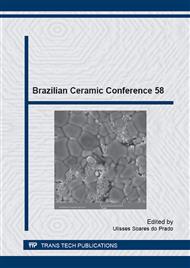p.167
p.172
p.181
p.187
p.193
p.199
p.205
p.213
p.218
ZnO-Nb2O5-TiO2 Dielectric Resonators and Porosity Influence on Dielectric Constant Values
Abstract:
The dielectric resonator (DR) is a ceramic component used in electronic circuits that can operate in microwave frequency range, where it plays the role of resonant element and enables the construction of high selective filters and oscillators. The dielectric properties of a ceramic resonator are influenced by their microstructure characteristics as pores amount. This work shows a study of the influence of pores amount (porosity) on the dielectric constant values of ceramics from ZnO-Nb2O5-TiO2 system. Mixtures of Nb2O5, ZnO, and TiO2 powders were compacted by uniaxial (100 MPa) and isostatic (300 MPa) pressing and sintered at 1100, 1200, and 1250°C. The experimental dielectric constant values of the sintered ceramics were corrected to eliminate the porosity influence. The results showed that the porosity, the type and quantities of crystalline chemical compounds in the ceramics influence the dielectric constant values.
Info:
Periodical:
Pages:
193-198
Citation:
Online since:
June 2015
Authors:
Price:
Сopyright:
© 2015 Trans Tech Publications Ltd. All Rights Reserved
Share:
Citation:


